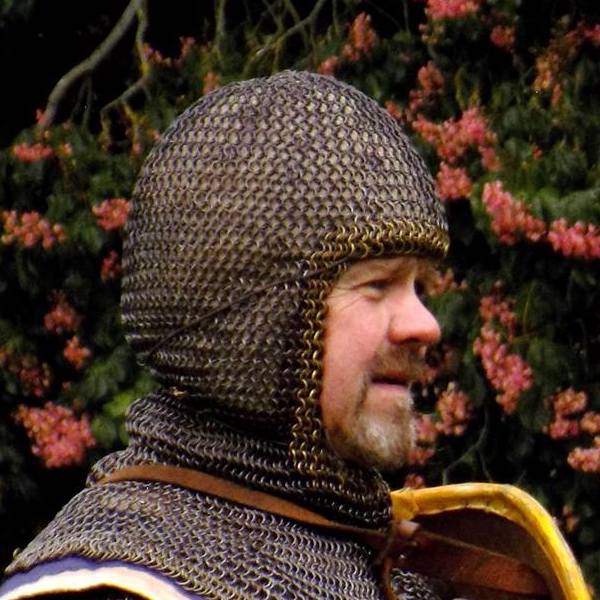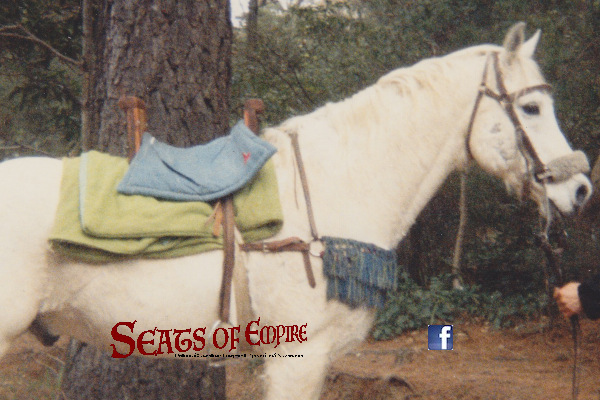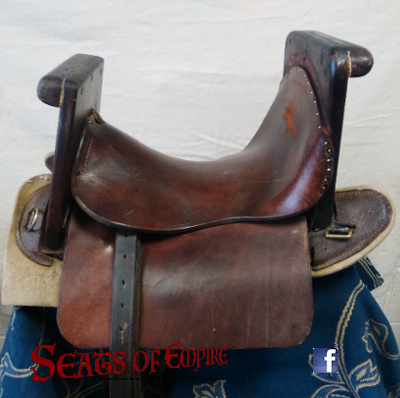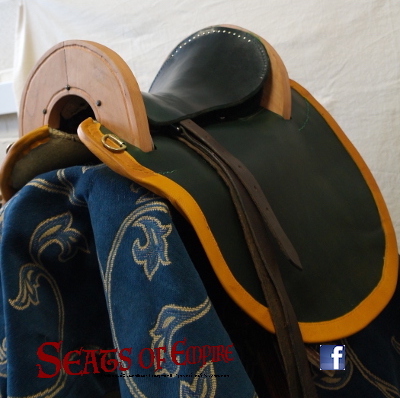News: November 2024
New products in several categories, and new pages: Bits and Testimonials.
The Maker: Dr. Timothy George Dawson
 |
I first became involved in re-enactment in 1979, bringing to the pastime established skills in dressmaking and metalwork. I took up riding in 1984 specifically to explore that aspect of the historical experience. Eschewing the stylised overlays of modern practice, I worked from the primary evidence for historical riding techniques for Classical Greece through to the Age of Chivalry. In the latter case, riding with long stirrups and sitting to every gait though all manoeuvres, and doing so in armour, as well as its protectiveness in battle, made the utility of the medieval war saddle manifest. So in 1985 I began constructing replica saddles, working up from the backs of my own horses. A range of functional eleventh- and twelfth-century saddles resulted, all built from scratch.

My first scratch-built Norman saddle based upon the Bayeaux Embroidery.

My most successful scratch-built Age of Chivalry saddle of the 1980s.
After that, I experimented with converting modern Universal Pattern military saddles. (Below left) And while I have continued to use that saddle until recently, revisiting the method (Below right), and considering UP saddles more critically, re-affirms the principle that a custom built saddle designed to fit the horse is a far superior route.

A Norman style saddle converted from UP in 1986. Last used at the Battle of Hastings re-enactment 2015.

A Steppe style saddle converted from UP in 2016.
For illustrations of my riding practice up to date using the equipment offered on this site please see the page called Examples of riding.
My papers and publications discussing historical equitation and equipment
Over the last decade, my practical developments have been complemented by increasing academic scholarship, as a colleague, Dr. Anastasija Ropa, and I pioneered what has now a become a growing trend in international scholarship, equestrian studies. My papers and publications in this field include:
- Echoing Hooves: Studies on Horses and their Effects on Medieval Societies, edited with Dr. Anastasija Ropa, Brill, Leiden 2022;
- ‘Playing chicken: the early history and modern revival of an ancient game’, co-authored with Jane Badger, in Historical Practices in Horsemanship and Equestrian Sports (provisional title), Trivent, Budapest 2022;
- ‘Baggage Animals – the neglected equines, an introductory survey of their varieties, uses and equipping’, in The Horse in Premodern European Culture, Anastasija Ropa and Timothy Dawson (eds.) De Gruyter, 2020;
- ‘Equestrian Attire: Why? What? When?’, International Medieval Congress, Leeds, July 2016;
- ‘Baggage Animals: the neglected equines?’, International Medieval Congress, Leeds, July 2017. Now published;
- Byzantine Cavalryman: Eastern Roman Empire, c.900 — 1204, Warrior Series, Osprey Publishing 2009;
- ‘Kremasmata, Kabbadion, Klibanion: Some aspects of middle Byzantine military equipment reconsidered’, Byzantine and Modern Greek Studies, 22, (1998) pp. 38 - 50.
My methods
The sidebars of my early saddles were carved from substantial pieces of wood to mimic the shape of the horses back, an approach that did lead to them being somewhat heavy and potentially fragile. The next mode of construction involved using curved timbers recycled from furniture, which suggested a better way. When I resumed building saddlery after a period focussing on other academic pursuits, these lessons coalesced. Thus, my sidebars are now made of Beechwood steam bent to an appropriate curvature and twist, or occasionally ply moulded similarly, affording a construction of maximum strength with minimum weight, and often a measure of flexibility. This result is also facilitated by superior woodworking techniques involving tenoning the arches into the sidebars and pinning them in place.
Basic models can be made approximating the standard categories of modern saddlery — narrow, medium and wide, but custom fitted saddles can be made on the basis of the industry standard method of saddle measurement. It must be acknowledged, that the fit of a rigid saddle tree is complicated by the fact that a horse’s shape can change somewhat from season to season. Should a horse show this characteristic strongly, this complication is allowed for by doing the measuring in the season in which the horse is most commonly going to be ridden for historical events, that is, of course, in Summer for Northern climates.
Highly built up and enclosing saddles, such as those of the late Age of Chivalry, also need to some degree to be fitted to the rider, which is also explained in the saddle measurement instructions.
Custom bridles have their own measurement instructions.
Copyright: Timothy George Dawson 2021

